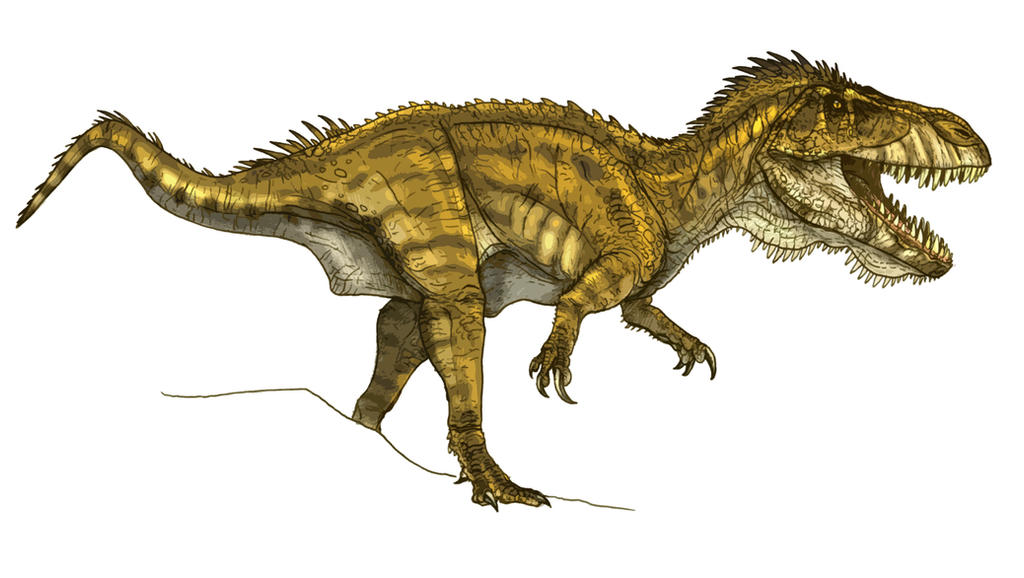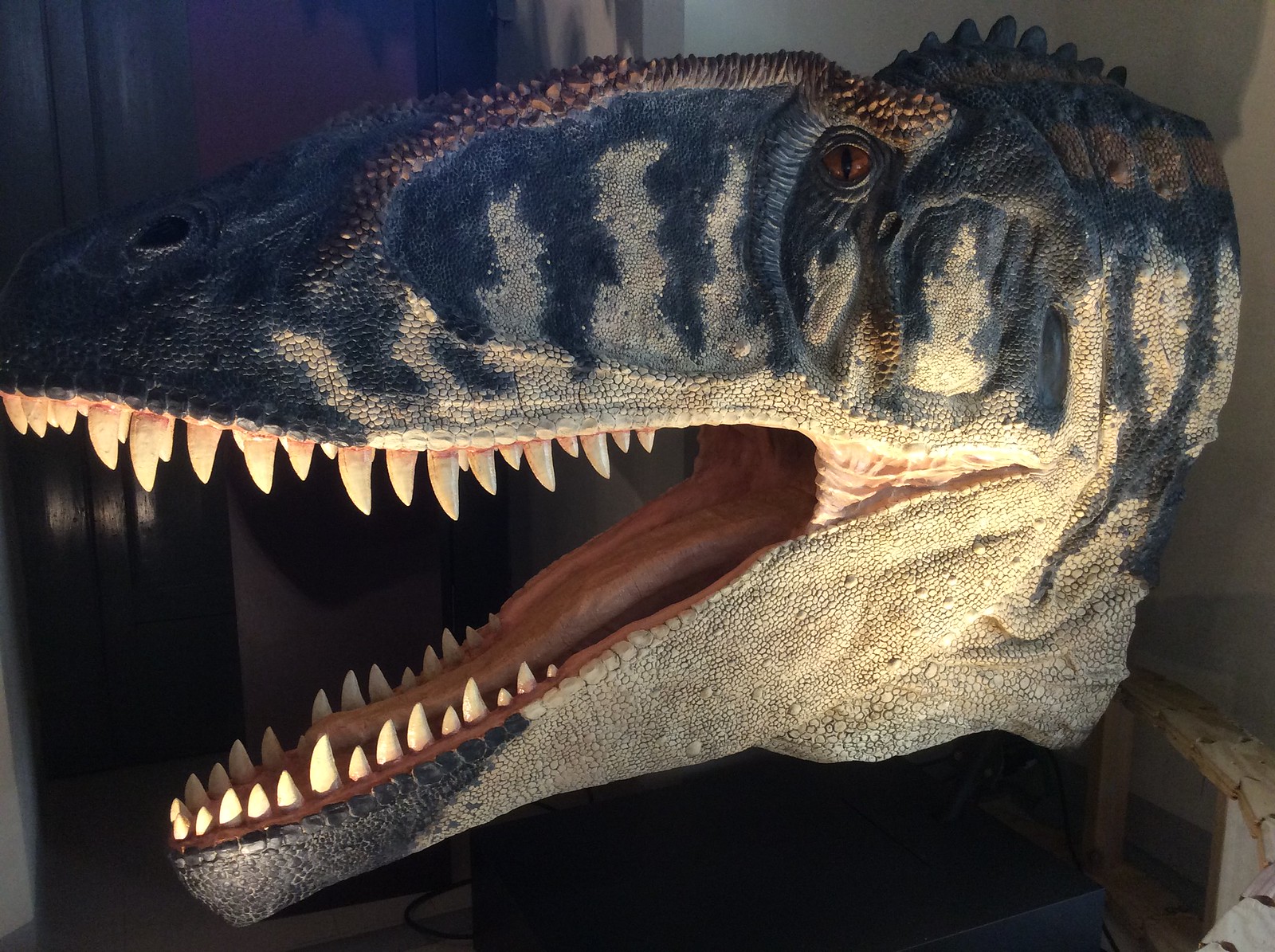Post by Carcharodon on Dec 17, 2013 4:15:46 GMT 5
Allosaurus fragilis
Allosaurus (play /?æl??s?r?s/) is a genus of large theropod dinosaur that lived 155 to 150 million years ago during the late Jurassic period (Kimmeridgian to early Tithonian). Allosaurus was a large bipedal predator. Its skull was large and equipped with dozens of large, sharp teeth. It averaged 8.5 meters (28 ft) in length, though fragmentary remains suggest it could have reached over 12 meters (39 ft). Relative to the large and powerful hindlimbs, its three-fingered forelimbs were small, and the body was balanced by a long, heavy tail. As the most abundant large predator in the Morrison Formation, Allosaurus was at the top of the food chain, probably preying on contemporaneous large herbivorous dinosaurs and perhaps even other predators (e.g. Ceratosaurus). Potential prey included ornithopods, stegosaurids, and sauropods. Allosaurus was a typical large theropod, having a massive skull on a short neck, a long tail and reduced forelimbs. Allosaurus fragilis, the best-known species, had an average length of 8.5 meters (28 ft), with the largest definitive Allosaurus specimen (AMNH 680) estimated at 9.7 meters long (32 ft), and an estimated weight of 2.3 metric tons (2.5 short tons). In his 1976 monograph on Allosaurus, James Madsen mentioned a range of bone sizes which he interpreted to show a maximum length of 12 to 13 meters (40 to 43 ft). As with dinosaurs in general, weight estimates are debatable, and since 1980 have ranged between 1500 kilograms (3300 lb), 1000 to 4000 kilograms (2200 to 8800 lb), and 1010 kilograms (2230 lb) for modal adult weight (not maximum). John Foster, a specialist on the Morrison Formation, suggests that 1000 kg (2200 lb) is reasonable for large adults of A. fragilis, but that 700 kg (1500 lb) is a closer estimate for individuals represented by the average-sized thigh bones he has measured. Using the subadult specimen nicknamed "Big Al", researchers using computer modelling arrived at a best estimate of 1,500 kilograms (3,300 lb) for the individual, but by varying parameters they found a range from approximately 1,400 kilograms (3,100 lb) to approximately 2,000 kilograms (4,400 lb).

Torvosaurus tanneri
Torvosaurus (play /?t?rv??s?r?s/) is a genus of large theropod dinosaur that lived during the Late Jurassic period (mid-late Kimmeridgian stage in North America, early Tithonian stage in Europe). The name Torvosaurus means "savage lizard" and is derived from the Latin torvus ("savage") and the Greek 
 /sauros ("lizard"). Fossilized remains of Torvosaurus have been found in North America and Portugal. Torvosaurus reached 9 to 11 meters (30 to 36 ft) in length and an estimated weight of about 2 metric tons (2.2 tons), which made it the largest carnivore of its time, except for Epanterias (which may have been just a big Allosaurus) and Saurophaganax.The size of Torvosaurus is not definitely known because only incomplete material has been found, but it was a large theropod. North American Torvosaurus material is estimated as belonging to an individual about 9.0 meters long (29 ft), with a weight of about 1.95 metric tons (2.15 tons). Material from Portugal indicates even larger animals. In 2006 a nearly complete maxilla found in Portugal was assigned to Torvosaurus tanneri. It measured 63 cm in length (2.13 ft), significantly larger than the 47 cm (1.54 ft) long maxilla of the American specimen (total skull length 118 cm [3.87 ft]). Based on this, a skull length of 158 cm (5.18 ft) was estimated for the Portuguese specimen. This is comparable to the largest T. rex skulls, and makes Torvosaurus the largest known Jurassic theropod (surpassing Saurophaganax/Allosaurus maximus and Edmarka), and among the largest of all theropods. A partial femur from another individual belongs to an animal estimated as 11 m (36 ft) long.
/sauros ("lizard"). Fossilized remains of Torvosaurus have been found in North America and Portugal. Torvosaurus reached 9 to 11 meters (30 to 36 ft) in length and an estimated weight of about 2 metric tons (2.2 tons), which made it the largest carnivore of its time, except for Epanterias (which may have been just a big Allosaurus) and Saurophaganax.The size of Torvosaurus is not definitely known because only incomplete material has been found, but it was a large theropod. North American Torvosaurus material is estimated as belonging to an individual about 9.0 meters long (29 ft), with a weight of about 1.95 metric tons (2.15 tons). Material from Portugal indicates even larger animals. In 2006 a nearly complete maxilla found in Portugal was assigned to Torvosaurus tanneri. It measured 63 cm in length (2.13 ft), significantly larger than the 47 cm (1.54 ft) long maxilla of the American specimen (total skull length 118 cm [3.87 ft]). Based on this, a skull length of 158 cm (5.18 ft) was estimated for the Portuguese specimen. This is comparable to the largest T. rex skulls, and makes Torvosaurus the largest known Jurassic theropod (surpassing Saurophaganax/Allosaurus maximus and Edmarka), and among the largest of all theropods. A partial femur from another individual belongs to an animal estimated as 11 m (36 ft) long.








